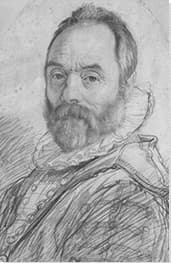Summary of Giambologna
Giambologna is one of the most distinguished sculptors in the history of art. A master of the Italian Mannerist style, he occupies a pivotal position in the timeline of Italian sculpture, providing the link between the periods of the High Renaissance and the Baroque (as exemplified by Michelangelo and Bernini respectively). Giambologna remains most revered for his dynamic marble portraits, and for the production of exquisite bronze statuettes that were avidly sought by collectors throughout Europe. Although a native of Flanders (France), Giambologna became an adopted Italian son, spending most of his career in Florence where he was employed as court sculptor by three successive Grand Dukes of the legendary Medici dynasty.
Accomplishments
- Giambologna was invested in the idea of beauty for beauty's sake and produced works that featured figures composed of sinuous lines, graceful curves, exaggerated poses, and an elegance that delighted the public. His greatest masterpiece, Abduction of a Sabine Woman (1574-82), is to Giambologna's legend what David (1501-04) is to Michelangelo's.
- Giambologna held a deep admiration for Hellenistic sculpture, and the works of Michelangelo. But he distinguished himself from his esteemed predecessors by accentuating more fully the asymmetrical contrapposto stance of his characters. The graceful, elongated Mannerist contours of his figures had the effect of revitalizing a somewhat stagnant Florentine sculptural scene. Giambologna's groups in particular, defined as they are by their entwined movement, required great technical skill and a precise calculation of physical stresses being placed on the materials he used.
- Giambologna was a master of the Mannerist feature known (to sculptors and painters alike) as the figura serpentinata (serpentine figure). But his winding figures convey not only movement, but human emotions such as aggression and fear too. He enhanced this sense of human drama by offering his viewer more than a single or primary vantagepoint of the work. To appreciate the totality of his art, Giambologna created works that could be circled and viewed, as it were, "in the round".
- Aside from his monumental pieces, Giambologna gained renown across Europe for his small to mid-size human and equine statuettes in marble and bronze. These highly prized collectables, including his Trotting Horses series, were of an exceptional quality and carried a remarkably fine level of detail. These pieces encapsulated Giambologna's mastery of bronze modelling and his skill in capturing the animal's grace of motion, and its air of strength and movement.
The Life of Giambologna
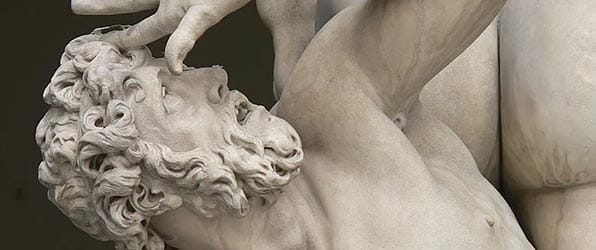
Historian Mary Weitzel Gibbons says that with the Sabine marble, the artist had created "the paradigm of the figura serpentinata, a form that began with Leonardo, was explored by Michelangelo, and was brought to full realization by Giambologna". It was a sculpture, she adds, that signalled a way to give "viewers a part to play in the 'narrative' of a work of art".
Important Art by Giambologna
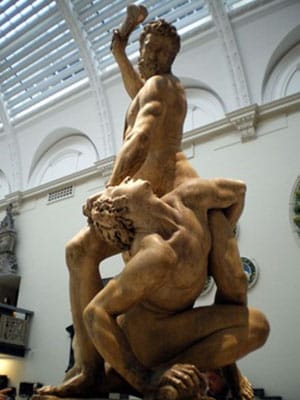
Samson and a Philistine
This work, which stands at just over two-meters tall, depicts a biblical episode in which the Nazirite leader, Samson, who had superhuman strength, has single-handedly slayed an army of Philistines (The Book of Judges: "And he (Samson) found a new jawbone of an ass, and put his hand and took it and slew a thousand men therewith"). Giambologna shows the mighty, muscular Samson standing over and straddling, a Philistine man. He wrenches the man's head backward by his hair, which he grasps in his left hand, as he raises the bone over his head with his right hand, poised to deliver the fatal blow.
Giambologna based this sculpture on a work by Michelangelo from the 1520s depicting Samson in combat (known only from a series of bronze casts of the original model). Like Michelangelo's work, Giambologna's takes on a pyramidal form, and shows multiple figures engaged in movement. However, this work exemplifies how, even early in his career, Giambologna was developing his own style, characterized by intense action and exaggerated contrapposto, and multiple viewpoints of the action. As the Victoria and Albert Museum explains, in terms of composition, Giambologna "put his own stamp on Michelangelo's original idea by choosing to eliminate [a] third figure, of the dead Philistine, from its base. Doing so meant he had to create a series of spaces between the lower elements of the two remaining figures that necessitated cuts into and even all the way through the lower part of the marble block. Excavating the marble to this extent presented huge technical challenges - the great weight of marble in the two bodies is supported by only five narrow points of contact with the base. But Giambologna obviously welcomed the opportunity to demonstrate his skill, and to imitate the virtuoso classical sculptures from the Ancient Greek Hellenistic period (approx. 323 BC - 31 BC) that he would have seen in Rome".
Originally commissioned by Francesco de' Medici to be part of a fountain in Florence, this monumental sculpture left Italy for Spain when it was presented as a diplomatic gift to the Duke of Lerma (the chief minister of King Philip III) in 1601. It was then re-gifted to England's Charles, Prince of Wales (later Charles I) in 1623 when he visited Spain to look into the possibility of marrying a Spanish bride. When the sculpture arrived in England, the work was gifted once more to Charles's friend and arts patron, the Duke of Buckingham. In England (and elsewhere), the work set new standards in technical and aesthetic skill and influenced many reproductions typically installed in the gardens of country houses.
Marble - Victoria and Albert Museum, London, England
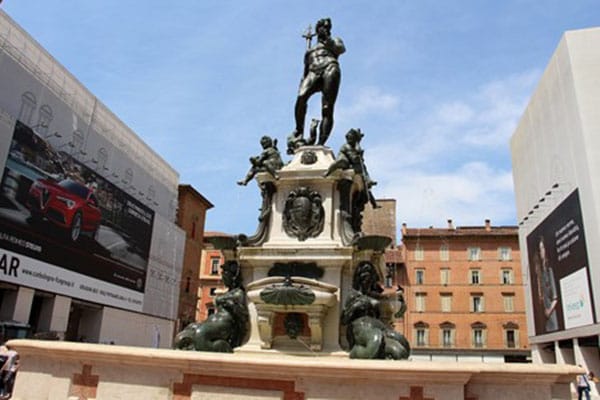
Fountain of Neptune
For this, Giambologna's first major commission, he had an opportunity to finally design a "Fountain of Neptune", after losing out in a competition (three years earlier) to Bartolomeo Ammanati to design just such a fountain for the Piazza della Signoria in Florence. Giambologna's Fountain of Neptune (known to Bolognaise citizens as, al Żigànt - "the giant") was in fact, a collaborative project with foundryman, Zanobio Portigiani, and architect, Tommaso Laureti, and was commissioned by the vice-minister, Pier Donato Cesi, to glorify the rule of Pope Pius IV. Taking center stage in Bologna's new Piazza del Nettuno, it was a political statement of power of the Church over the city, with the flowing water symbolizing new wealth and fertility. The creation of the fountain was, indeed, part of a larger project in Bologna to visually celebrate the city's new status. After 150 years of being an independent commune, Bologna had become a member of the Papal States.
Giambologna designed the bronze sculptures, which include a larger-than-life figure of the God Neptune, as well as four Nereids (female sea spirits) holding their breasts (with water flowing from their nipples into basins), four cherubs wrestling with lively dolphins (representations of what were then considered the four major waterways of the earth: the Ganges, the Nile, the Amazon, and the Danube), as well as masks, shells, and other decorative elements associated with aquatic life.
The theatricality of the fountain - which adorns the city center to this day - is typical of the Mannerist style. Neptune reaches out his left hand in a commanding pose, as if he is directing the waters of the ocean to submit to his will. He holds a trident in his right hand and adopts a marked asymmetrical contrapposto stance; his energetic pose exemplified by the twisting turn of his head. While Neptune's powerful body represents physical and political strength, his aged face is meant to indicate the wisdom of the Pope.
Bronze and stone - Bologna, Italy
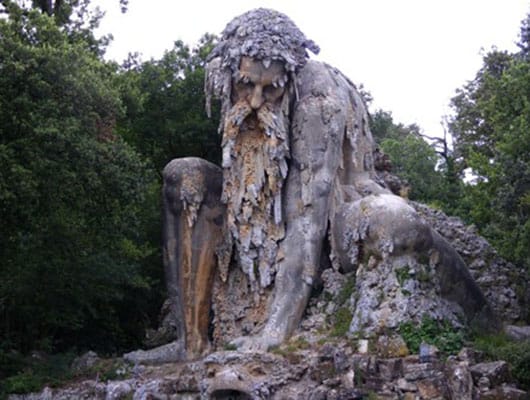
Apennine Colossus
At thirty-five feet high, the Apennine Colossus, representing the mountain God Appennino, is Giambologna's largest sculpture. It is situated at the base of the Apennine mountain range, 10 kilometers north of Florence. Appennino is shown here as a naked elderly man, with long hair and beard, crouching at the shore of a lake. The figure has a rugged surface, with his beard and mustache appearing almost like stalactites, symbolizing the connection between man and nature. It was created for the gardens of the Villa di Pratolino, which was built by Francesco de' Medici, Grand Duke of Tuscany, to impress his Venetian mistress, Bianca Cappello.
The sculpture contains a system of pipes, allowing water to fall fountain-like from Appennino's eyes, mouth and body. But he is more than just a sculpture. Appennino acts as a facade to a network of passageways and grottoes, adorned originally with statutes and frescoes of muscular men, precious metals, shells, corals, pearls, and crystals (most of these artefacts were relocated to new homes after Francesco's death). A ground-floor grotto contains an octagonal fountain dedicated to the Greek water goddess Thetys, while Appennino's head housed a chamber big enough to accommodate a small orchestra. His head also contained a fireplace that allowed smoke to exit through the Appennino's nose. Appennino also has slits in the eyes and ears, through which Francesco originally enjoyed casting his fishing line. At night, the eyes would also hold torches, causing the eyes to glow.
The grottoes were initially accessed through the back of the sculpture, but this was altered in 1590 by the sculptor Giovan Battista Foggini, who demolished the cave entrance and erected a doorway with a stone dragon above in its place (the dragon is there to this today). The Villa Demidoff, as it was now known, was purchased by a Russian family in 1872. The Villa was then procured by the Province of Florence in 1981. The beautifully manufactured brick which is coated with plaster and stone has been restored to its former glory thanks to restoration projects which took place between the fall of 2011-14. Legend has it that "Giambologna made the Apennines but was sorry that he did in Pratolino". This was not because Pratolino was undeserving of a work of such magnitude but, rather, had the Apennines been in the Piazza della Signoria in Florence, or any other civic square in a major Italian city for that matter, it would today be one of the most famous attractions in the world.
Stone and brick - Villa di Pratolino, Vaglia, Tuscany
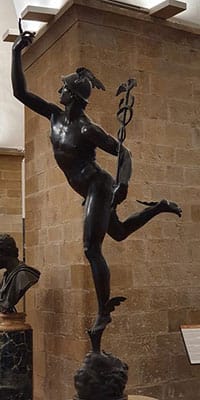
Mercury
Giambologna's Mercury, the Roman messenger God, is poised precariously on just the toes of his left foot. He "pirouettes" atop a column of air issuing forth from the mouth of Zephyrus, one of the Greek wind Gods. Mercury's right leg kicks backwards, his right hand is raised above his head pointing toward Jupiter. His left hand carries a caduceus (a short staff with two entwined serpents) close to his body. As is typical of representations of the God, his feet have wings, and he wears a winged helmet on his head.
Arts editor Kathleen Kuiper notes that "Giambologna uses the shimmering play of light on the figure's smooth surface to enhance the effect of fleetness". This work was in fact inspired by earlier bronzes in the Medici collection, such as Boy With A Dolphin (1465) by Andrea del Verrocchio, and Mercury (1515) by Rustici. Giambologna's Mercury was originally intended to be part of a fountain at the Villa Medici in Rome. In that setting, water would have flowed over the head of Zephyrus at the base, increasing the appearance of Mercury floating in place. It is markedly Mannerist in style, in that it can be equally appreciated from any vantage points such is the elongation of the figure, and the elegant arabesque pose.
The famous historian E. H. Gombrich said of the work, "The whole statue is so carefully balanced that it really seems to hover in the air - almost to speed through it, with swiftness and grace. Perhaps a classical sculptor, or even Michelangelo, might have found such an effect unbecoming to a statue which should remind one of the heavy block of matter on which it was shaped - but Giambologna, no less than Parmigianino, preferred to defy those well-established rules and to show what surprising effects could be achieved".
Bronze - Bargello Museum, Florence, Italy
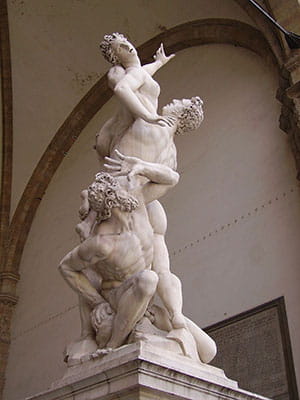
Abduction of a Sabine Woman (Rape of a Sabine Women)
Giambologna's most famous work, this large sculpture, carved from a single block of stone, was created for Francesco de' Medici, Grand Duke of Tuscany. It depicts a scene from early Roman history/mythology, in which the men of the newly-founded Rome abducted dozens of virgins from nearby areas in order to procreate and increase the Roman population to ensure its viability. This statue stands in the Loggia dec Lanzi in the Piazza della Signoria of Florence, while a plaster cast model is housed in Florence's Academia gallery. Art historian Dr. Shannon Pritchard explains that the specific scene Giambologna chose to represent was of a Roman man successfully abducting a Sabine woman, and standing over a Sabine man who cowers in defeat. She notes that the use of the word "rape", which in English has obvious connotations with sexual violence, in the original title of the work can cause confusion, as the Latin term "rapito" translates more accurately to an abduction.
As in Samson and a Philistine (1567), Abduction of a Sabine Women demonstrates the way in which Giambologna distinguished himself from Michelangelo by skillfully and drastically undercutting the sculpture (as had been done in much of the Hellenistic sculptural work he had studied). Undercutting refers to the technique of removing material from a sculpture so as to create an overhanging or concave portion. This work exemplifies the figura serpentinata (serpentine figure) typical of the Mannerist movement, which, according to Pritchard, conveys "movement, aggression, fear, and struggle, as [the figures] move upward in a flame-like or twisting pattern". This work also demonstrates Giambologna's characteristic style of creating complex group compositions that can be appreciated from multiple viewpoints, which, again according to Pritchard, enhances the sculpture's "sense of frenetic energy".
Says Pritchard, "The Abduction of the Sabine Woman proved to be Giambologna's entrée into the Florentine world of monumental sculpture. From this point forward he went on to create numerous other works that occupy principal sites in Florence, including the Cosimo I de'Medici Equestrian Monument in the Piazza della Signoria, St. Luke for a niche at Orsanmichele, and a brilliant Hercules Battling the Centaur, which is situated just a few feet from his Sabine group".
Marble - Loggia dec Lanzi, Piazza della Signoria, Florence, Italy
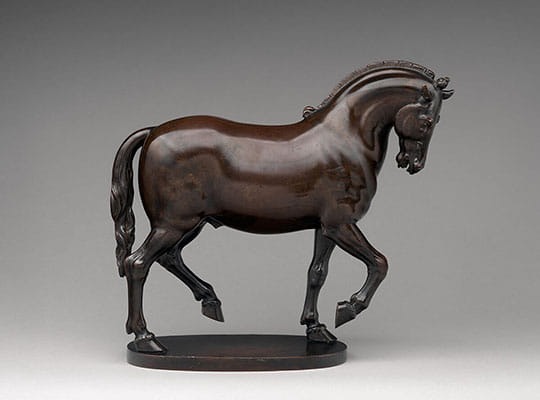
Trotting Horse
Giambologna was highly regarded for his marble and bronze statuettes which were coveted by connoisseurs across Europe and were often offered to dignitaries and state officials by the Medici as diplomatic gifts. Trotting Horse (or the "Met Horse" as this example is known) has been traced back to Giambologna's workshop and can be linked to an important lineage of bronze statuettes associated with the Flemish master. It is one of several horse variations attributed to his workshop and belongs, indeed, to the grand tradition of equestrian sculpture in Greek and Roman antiquity. The Met Museum writes, "Giambologna's dedication to meeting (or creating) market demand for his small equestrian bronzes is well documented, going back to at least 1563". The Met Horse is, however, "the fruit of a quite early cast, which can be placed in the last decades of the sixteenth century. This early dating would explain the use of an oval base and the statuette's exceptional quality". In this example, the magnificent animal is free of all adornments, but others attributed to the sculptor's workshop have added features such as riding equipment and sheaths attached to tails. The dark and evenly lacquered finish lends the statuette a deceptively modern appearance.
As one had come to expect of works carrying Giambologna's name, The Met Horse shows a remarkable level of detail, with a mastery of bronze modelling that encapsulates the animal's grace of motion, and its sense of strength and movement. Featuring, as it does, a lone pacing horse, captured mid-trot and alive with motion from every angle, The Met Horse can be viewed thus as one of the artist's preparatory statuettes for his Equestrian Monument of Cosimo I de' Medici (completed three years later).
Bronze - The Metropolitan Museum of Art, New York
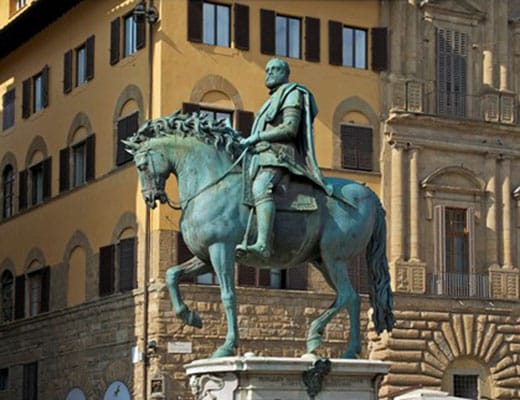
Equestrian Monument of Cosimo I de' Medici
This Equestrian Monument of Cosimo I de' Medici (Cosimo I) is a bronze statute erected in 1594 in the Piazza della Signoria in Florence. It was commissioned after his death by Cosimo's son (Ferdinando). Cosimo, the Grand Duke of Tuscany, sits confidently atop a prancing horse thereby establishing a visual connection with the ancient Roman Emperors. Indeed, Cosimo adopted the same zodiac sign as the first emperor, Augustus, since, like him, Cosimo had overthrown a republic to create a new sovereign state (Florence).
Cosimo holds a military baton, armor, and sheathed sword. The horse is robust, compact, and muscular, with bulging veins and eyes, and pricked-up ears. The animal's short body and rounded rump is brought to life by the raised front hoof, its wildly curling mane, and its sinuous tail. For his part, a bare-headed Cosimo holds a military baton, armor, and sheathed sword. On the statue's base are three bas-reliefs depicting episodes of Cosimo's life: The election as duke, which took place in 1537; The conquest of Siena of 1555; and The conferral of the title of Grand Duke in 1569. Each bas-relief with an explanatory cartouche (carved tablet or scroll) at the top, written in Latin.
This work carries on the Classical Roman tradition of equestrian monuments as a testament to a ruler's power (in the manner of the Equestrian Statue of Marcus Aurelius (c. 175 AD) in Rome). Standing in the same piazza as Bartolomeo Ammannati's Fountain of Neptune (1563), the sculptural pairing references Cosimo's ambitions both at sea and on land. Giambologna's was the first monumental equestrian statue in Florence. It proved an immediate success and was widely replicated as statuettes with a variety of different riders. A full-size variant, showing Ferdinando I de' Medici, was commissioned soon after for the Piazza Santissima Annunziata, while others in this design followed for the kings of France and Spain.
Bronze - Piazza della Signoria, Florence, Italy
Biography of Giambologna
Youth and Education
The artist known commonly as Giambologna was born, Jean de Boulogne, in Douai, Flanders (now France). What little is known of his childhood tells us that, at the age of fourteen, he was apprenticed to Flemish sculptor and architect (and master artist to Emperor Charles V) Jacques Du Brœucq who worked in an "Italianate" (or Classical) style. Through Du Brœucq, Giambologna mastered techniques in modeling and carving and learned the style which Du Brœucq had himself absorbed after closely studying Greek sculpture in Rome.
Early Career
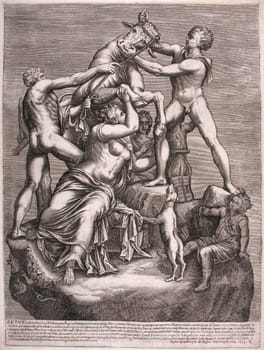
In 1550, Giambologna travelled to Rome where he made detailed models of Greco-Roman and Renaissance sculptures. He was especially drawn to complex groupings of figures in action, such as the enormous Hellenistic sculpture, The Farnese Bull, which was excavated in 1546. He also found inspiration in the works of Michelangelo and other Renaissance artists. He is reported to have even met and elderly Michelangelo who, according to art historian Giorgio Vasari, criticized the young artist for developing too high a finish on his work before the basic pose had been properly established (although this was a complaint levelled at Northern Renaissance sculpture generally). This rebuke from the great master is said to have led Giambologna to adopt the practice of making preparatory sketch-models in wax or clay. While in Rome, he also befriended fellow Northern sculptor Willhelm Tedrode, and Italian architect Gugliemo della Porta.
In 1553, on his way home to Flanders, Giambologna stopped off in Naples and Florence to study works by Donatello and Michelangelo. While in Florence, he met arts patron Bernardo Vecchietti, who provided the young artist with accommodation and financial support. He also arranged an introduction to the Grand Duke of Tuscany, Francesco De' Medici (son of Cosimo de' Medici, the ruler of Florence). Giambologna duly abandoned his decision to return to Flanders and settled in Florence.
Giambologna entered a design in a competition for a "Fountain of Neptune" for the Piazza della Signoria in Florence. Although his bid was unsuccessful, Giambologna's full-scale clay model impressed the judges and Duke Francesco, who duly became his primary patron. Other sculptors who participated in the competition included Tuscan mannerist Bartolomeo Ammanati (who won the commission) and Perugian Renaissance sculptor, Vincenzo Danti. These two men would become Giambologna's primary rivals throughout his career, with each man seeking any opportunity to undermine the others. As art historian Michael W. Cole explains, at one point "Giambologna tried to persuade the duke to reduce Danti to a kind of assistant, overseeing the quarrying of marbles for Giambologna's own works", while in 1578, Ammanati announced that he "had heard" that Giambologna was responsible for instances of vandalism at the Severezza quarries.
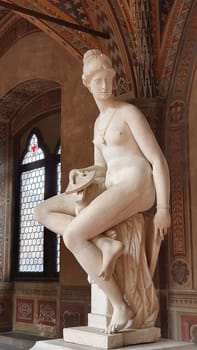
During his early years in Florence, Giambologna created several large sculptural works in bronze and marble for public spaces and the Medici gardens. His workshop also began to produce bronze statuettes, which were becoming hugely popular with collectors across Europe. These were often offered as gifts by the duke to visiting dignitaries. In 1563 Giambologna became a member of the newly founded Accademia Delle Arti del Disegno, an elite Academy reserved for the most eminent artists working in the Medici court. Between 1560-67 he produced one of his most iconic works, Samson and a Philistine. With this magnificent sculpture, Giambologna showed multiple figures engaged in violent and anguished movement that recalled Hellenistic masterpieces such as Laocoön and his Sons (c. 42-20 BCE). It was commissioned by Francesco de' Medici to be part of a fountain in Florence.
Mature Period
Giambologna received his first commission from Pope Pius IV for a colossal bronze Neptune and secondary figures for the Fountain of Neptune in Bologna. Giambologna's Neptune, completed in 1566, was modelled on Michelangelo's Victory and cemented his reputation. It led to further commissions across Italy. Indeed, Giambologna was by now the most important court sculptor of the Medici family, with the scale of his Florence workshop growing proportionally with his fame.
The Medici kept Giambologna on a tight rein, fearing that if he ventured too far from Florence, either the Austrian or Spanish Habsburgs would attempt to bring him into their employ. In fact, Giambologna reported to his employer at one point that he had turned down "enormous" offers from "the king of Spain and from the Emperor in Germany" (it is thought he did sometimes make works "in secret" for foreign patrons). In 1580, Giambologna unveiled his largest sculpture. Some thirty-five feet high, and acting as a façade to a complex of passageways and grottoes, the Apennine Colossus, which represented the mountain God Appennino bending down over a lake, is situated at the base of the Apennine mountain range to the north of Florence.
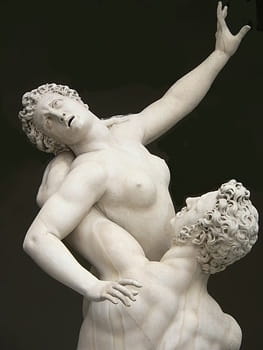
In 1582 he unveiled Abduction of a Sabine Woman, thought by many to represent the pinnacle of his achievements. The three characters are entwined in a spiral composition that is almost alive with movement. Giambologna's composition was also designed so that it can be viewed from any side with equal effect. Historian Dr. Shannon Pritchard writes that, "[In] the center of Florentine life and politics - were the truly monumental sculptures, including Michelangelo's David (1504), Baccio Bandinelli's Hercules and Cacus (1525-32), and Bartolommeo Ammanati's Neptune Fountain (1565). Thus, Giambologna also wanted to prove himself as a sculptor of monumental works. And as the story is told, Giambologna undertook the Sabine project without any specific subject in mind with the only goal being to produce a complex multi-figural group. When the work was nearly complete and placed in the Loggia dei Lanzi in August of 1582, it was referred to simply as 'group of three statues,' as no one knew what the subject was. However, just a short time later, the work was interpreted as representing an ancient Roman event, and Giambologna produced a bronze narrative relief to be inserted into the base of the sculpture to help clarify the content of the three figures above".
Death
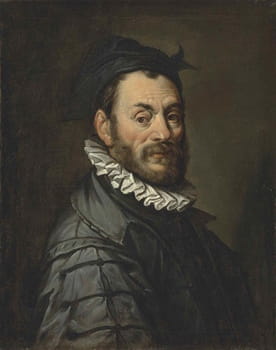
Giambologna died in 1618, aged of 79, in Florence and was interred in a chapel of his own design (and which he had funded with his own savings) in the Basilica della Santissima Annunziata. According to Urbinate ambassador Simone Fortuna, Giambologna was "the best sort of man one could ever want to meet, not greedy at all, as one can tell from his being so poor: all that he want[ed was] glory and his greatest ambition [was] to rival Michelangelo. In the judgment of many, he has already done so".
The Legacy of Giambologna
Giambologna was one of the most significant sculptors in the timeline of classical art. Arts editor Kathleen Kuiper writes, "An Italian sculptor in all but birth, Giambologna transformed the Florentine Mannerism of the mid-16th century into a style of European significance. His ability to capture fleeting expression and the vivacity and sensual delight of his mature style anticipate the Baroque sculpture of Gian Lorenzo Bernini. For three centuries his work was more generally admired than that of any sculptor except Michelangelo".
Giambologna's direct influence was most pronounced in the work of Bernini. Commenting on the similarities between Giambologna's masterpiece, Abduction of a Sabine Woman, and Bernini's group sculpture, Pluto and Proserpina (The Abduction of Proserpina), historian Dr. Shannon Pritchard notes (in the latter) that "the forward stride of Pluto, the elevation of Proserpina above his head [...] and her outstretch arms and anguished face all point directly to the influence of Giambologna's Sabine group". Pritchard notes, too, that it "wasn't only other sculptors who were responsive to Giambologna's sculpture". Painters of the stature of Nicolas Poussin and Pietro da Cortona "executed paintings of the same subject and clearly borrowed from both Giambologna's Sabine figural group, but also his bronze narrative relief [at the base of the sculpture] as well".
Influences and Connections

-
![Michelangelo]() Michelangelo
Michelangelo -
![Donatello]() Donatello
Donatello - Jacques Dubroeucq
- Il Tribolo
- Pierino da Vinci
- Willelm Tedrode
- Gugliemo della Porta
- Bernardo Vecchietti
-
![Gian Lorenzo Bernini]() Gian Lorenzo Bernini
Gian Lorenzo Bernini - Adriaen de Vries
- Pietro Francavilla
- Pietro Tacca
- Alessandro Algardi
- Willelm Tedrode
- Gugliemo della Porta
- Bernardo Vecchietti
Useful Resources on Giambologna
- Giambologna, Narrator of the Catholic Reformation (1995)By Mary Weitzel Gibbons
- The Story of ArtBy E. H. Gombrich
- Ambitious Form: Giambologna, Ammanati, and Danti in FlorenceOur PickBy Michael W. Cole
- Shadows of Time: Giambologna, Michelangelo and the Medici ChapelOur PickBy Stephan Koja and Claudia Kryza-Gersch
